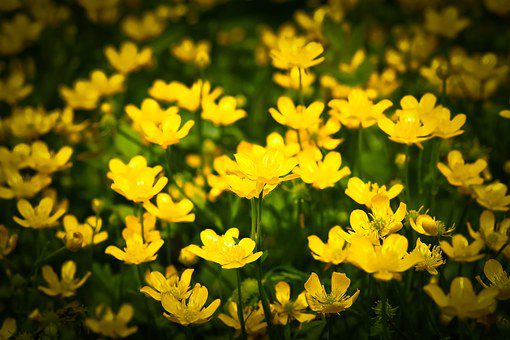
Last updated on May 20th, 2023 at 09:26 pm
The celandine flower is unique as it shows up as “greater celandine,” “lesser celandine,” and the “celandine poppy.” While wildflowers, the greater celandine and celandine poppy, belong to the Poppy family (Papaveraceae), the lesser celandine belongs to the Buttercup family (Ranunculaceae). Then why are they named the same? Because the flowers of the lesser celandine flower resemble that of the greater celandine, except in size.
Interestingly, the celandine flower is from the Greek ‘chelidon,’ which means ‘swallow,’ referring to the bird. It was observed that the flowers bloomed with the arrival of the swallows, and when the swallows departed, the blooms died.
The greater celandine is scientifically known as Chelidonium majus and is commonly referred to as the swallow wort. Introduced in North America in the 1600s from Eurasia for its medicinal properties.
The celandine poppy is scientifically known as Stylophorum diphyllum. It is commonly called wood poppies. It is native to North America and China and grows as a garden plant.
The lesser celandine scientific name is Ficaria Verna syn Ranunculus ficaria, commonly called the fig buttercup. It arrived in North America from Eurasia in the 1800s as an ornamental plant.
What does the Celandine flower symbolize?
The lesser celandine flower is associated symbolically with the return of the sun (Europe). This is because they bloom from March through May, signaling the arrival of spring after the cold winter. It symbolically serves as a reminder that seasons change.
During the Victorian era, they symbolized the prospect of ‘joys to come.’ Floriography, or the language of flowers, where each flower and color were given a meaning, reached its peak popularity during this era. So the lesser celandine flower heralded hope and cheer in people’s minds, giving them something to look forward to.
The lesser celandine flower appears in yellow, white, and green. The greater celandine and the celandine poppy are both yellow. The celandine flower meaning for each color is different.
All in all, the celandine flower symbolic meanings are:
- peace
- sleep
- pleasure
- hope
- resilience
- fertility
- remembrance
- sacrifice
Meaning of the Celandine flower colors
White color
White celandine represents peace, innocence, humility, elegance, healing, and sympathy.
Yellow color
Yellow celandine means energy, joy, friendship, youthfulness, hope, and happiness.
Green color
Green celandine signifies growth, new beginnings, wealth, and good fortune.
Interesting facts about the Celandine flowers
- The greater celandine is a biennial or short-lived perennial, whereas the lesser celandine is a perennial.
- The greater and the lesser celandine are non-native plants, while the celandine poppy is native to North America.
- The greater celandine plant grows to 75 cm (29.5 inches), while the lesser celandine grows a few inches off the ground. The celandine poppies can grow up to 2 ft.
- The greater celandine flower has 4 petals, similar to the celandine poppy, while the lesser celandine has 7-12 petals.
- The greater celandine and celandine poppy produce only pollen and no nectar.
- All the celandine namesakes have yellow flowers, and the size of the celandine poppies is double the size of the greater celandine.
- Native Americans used the orange-yellow sap found in the celandine poppy as a dye for baskets and fiber. The color was also used as war paint.
- The lesser celandine gets its common name of ‘Fig Buttercup’ because the underground tubers are shaped like a fig. The shape of the flower is like that of a buttercup. In turn, the buttercup is called so, for people mistakenly associate the butter color with yellow because of the cows eating these flowers!
- The lesser celandine is also called ‘spring ephemeral.’ They bloom in spring and suddenly disappear from the surface.
- The different cultivars of the lesser celandine are namely: collarette (double yellow flowers), salmon’s white (open-shaped flowers), and brambling cultivar (unusual bronze horseshoe-shaped foliage).
- The celandine poppies attract pollinators, and chipmunks and mice eat their seeds.
- The greater celandine is a medicinal herb used to treat warts, eye infections, and liver diseases and relieve toothache. The lesser celandine is used for treating hemorrhoids and ulcers, and a traditional treatment for piles, leaves, and petals has been used to clean teeth.
- The edible parts of the lesser celandine are the leaves, especially before the plant flowers and the starchy roots. The parts must be cooked before consumption; otherwise, they are toxic.
- A note of caution—though these plants have medicinal properties, they also have high to low-severity toxic elements. So exercise caution while using.
How to grow Celandine flowers
The blooming season of the celandines varies, with the greater celandine flowers appearing from May to August, the lesser celandine flowering from March to May, and the celandine poppies blooming from April to June.
- Plant celandine in rich, moist soil.
- Place them in shaded areas with partial sunlight.
- There should be at least one foot of space between the two plants.
- Do not allow them to grow too close, or they will leach nutrients from each other.
- Fertilize them with a reasonable amount of compost
- Give them water evenly all through the summer.
How to care for Celandine flowers
- Replicate the soil with lots of composted organic material, moist and well-drained humus-rich soil.
- Do not let the soil dry out.
- Deadhead to have continuous flowers.
- Pick flowers regularly to make the plant bushier and encourage them to have more flowers.
- Apply mulch late in the fall, after the ground has already become cold, and if possible, wait until the first frost.
- Let them self-sow.
Best time to gift Celandine flowers
The celandine flower meaning list gives us a reason to give the flowers appropriately. Wildflowers in bouquets are always a welcome sight, for it brings the naturally growing flowers into the cultivated varieties.
Gifting someone with yellow flowers is appropriate when you wish to cheer up a friend, offer congratulations on achievement, and renew the bonds of friendship. And since the predominant color of the celandines is yellow, they bring freshness and brightness to a bouquet.
While flowers are usually gifted, you could also give the plant to someone with a garden so that they can enjoy the flowers’ beauty for a longer time.
Conclusion
Celandine is a beautiful low-growing plant with a rich history, but if allowed to expand unchecked, it can become a nuisance that drives out other more delicate marsh plants.
Take responsibility for any celandine that you plant and keep it controlled. Choosing the proper kind with low invasive potential will allow you to appreciate its beauty and symbolism without putting the environment at risk.
If you want to know and learn more about flowers, we at PansyMaiden can help you. Check out our fun, easy-to-read, and informative flower-related content that you will surely enjoy!

